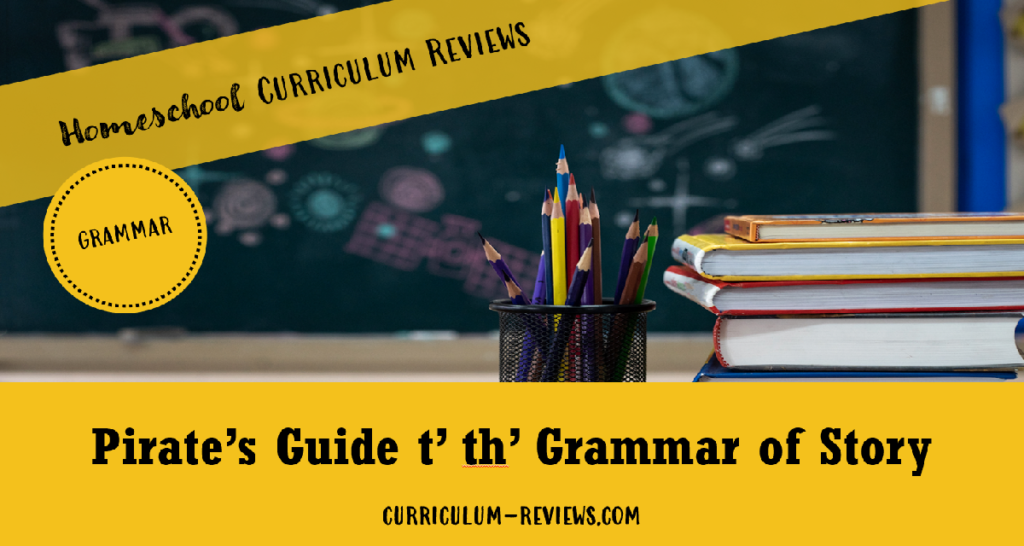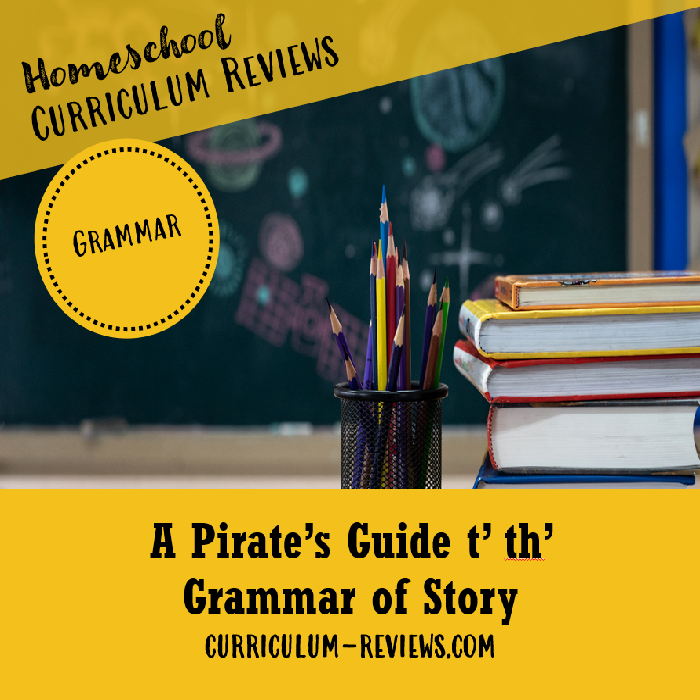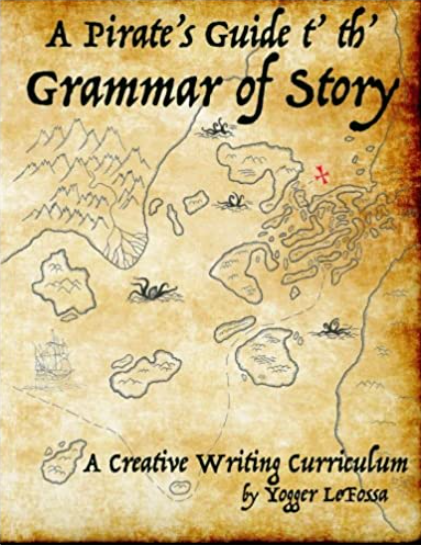
A Pirate’s Guide t’ th’ Grammar of Story
Target Grade Level: 5th – 8th
Not often will you get the advice to start reading a book on page 322, but that’s exactly what I’m going to tell you to do with A Pirate’s Guide t’ th’ Grammar of Story. There, you will find a Note from the Publisher, where parents get the straightforward scoop about this curriculum. I’m going to emphasize 2 points:
1. Students will work hard to finish this course.
2. Parents should expect to be part of the creative writing process.
A Pirate’s Guide t’ th’ Grammar of Story is a workbook written for students. Switching between the narrative voice of the treasure-hunting Captain Yogger LeFossa and the objective voice of the curriculum instructor, A Pirate’s Guide jumps right into its pirate premise.
Students are introduced to their role as Scurvy Spat, Captain Le Fossa’s new junior pirate. [If you’ve never read a story written in the 2nd Person, meaning the narrator is YOU, you’re in for a delightful but unusual treat.] This fictional tale weaves itself throughout the book, illustrating various writing objectives in each of the 26 lessons.
Chances are, kids chomping at the bit to write their own novel might not appreciate the thoroughness of A Pirate’s Guide approach to creative writing. But, there’s a lot to like about this curriculum.
On the one hand, most kids will be thrilled by the lack of actual grammar lessons in the workbook. Even though A Pirate’s Guide titles itself as the Grammar of Story, you’re not going to find instruction on noun-verb agreements, dangling participles, or dependent clauses.
Instead, you get strong and exhaustive lessons built upon the fundamentals of good writing. The book covers the essential elements of the creative writing process, such as descriptive language, plot, conflict, story arcs, developing voice and much more, along with a heavy emphasis on characterization.
Keep in mind, the curriculum was originally written for professional writers and adapted for kids by building a pirate theme into it. The pages are packed with hundreds of list-making and deceptively simply writing activities that guide young writers into appreciating how deep backstories delve before characters begin to tell their story to a reader.
A Pirate’s Guide focuses on the task of learning the craft of creative writing without the distraction of color or clipart. Even Captain Yogger’s ongoing tale is void of illustrations. What it lacks in visual appeal is more than made up with the thoroughness in which is covers the technical aspect of creative writing.
So, what about the need for parent participation?
A Pirate’s Guide helps kids learn the elements of writing but when it comes time to apply what’s been learned, it takes a lot of, well, creativity. You’re probably thinking, “Well, yeah . . .”
Here’s the thing. coming up with a list of your top 10 fictional characters is pretty easy. Maybe brainstorming 20 character names that reflect certain traits might not be too hard. But when the activities begin to require analysis, like discerning how characters can have conflicting emotions or desires while remaining believable – well, that’s a lesson that can use some adult guidance.
Creative writing also requires feedback in order for a writer to grow and improve. Sometimes, a young writer knows what they want to say, but their thoughts get in front of their words. What winds up on paper isn’t always the story the writer saw in their mind’s eye. It’s not that the student did the assignment wrong. It’s more a matter of needing help with organizing thoughts.
Unfortunately, A Pirate’s Guide does not include rubrics that parents can use to help judge if their young author mastered the elements of an assignment. That is (probably) why the publishers encourage parents to do the writing assignments along with their kids.
The book bills itself as appropriate for ages 12 and up. Given the level of rigor and self-discipline it will take to successfully complete A Pirate’s Guide, the publishers are spot on with that age guide.
I’ll just add the caveat that kids who use this book have got to buy into the pirate theme because many of the writing activities are direct extensions of the pirate story that runs throughout the book. Definitely read through the sample pages at Amazon to make sure your older teen appreciates the humor.
 About the Authors: Captain Yogger LeFossa (aka Christopher Hansen) is a professional story designer who works with writers, directors, producers, actors, and illustrators to liberate their creative potential. He has a Film degree from Vermont’s Middlebury College and is a homeschool dad. Co-author, J.R. Fehr, is a journalist and short-film maker living in Canada.
About the Authors: Captain Yogger LeFossa (aka Christopher Hansen) is a professional story designer who works with writers, directors, producers, actors, and illustrators to liberate their creative potential. He has a Film degree from Vermont’s Middlebury College and is a homeschool dad. Co-author, J.R. Fehr, is a journalist and short-film maker living in Canada.
Date of Review: 8/26/2016
NOTE: The publisher submitted a free copy of this curriculum for review. No other compensation was received for this review.


